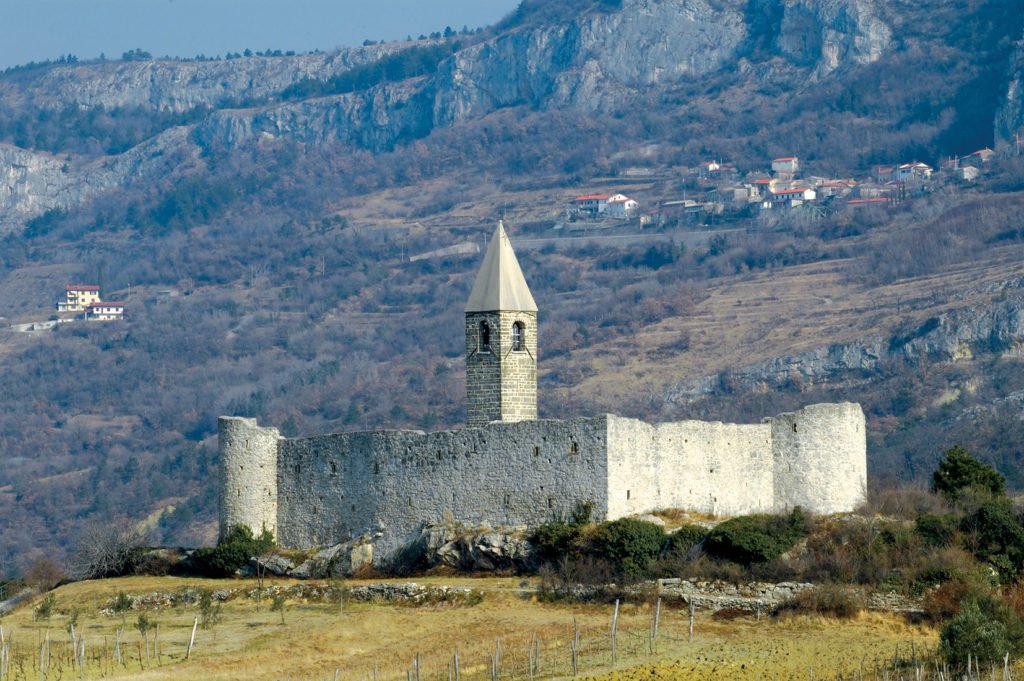
A merging of religion, art and history
Hrastovlje (pron. hrastovlye) is the name of a small ancient village in the coastal region of Slovenian Istria. In Slovenian language it means the place of oaks. Since the discovery in the fifties of the Gothic frescoes under several coats of white paint, the name has been associated with the 12th century village church standing on the slopes above the village. The discovery of the Death Dance- usually referred to as Dance macabre – a rare, well preserved, and complete example of one of the most famous images of medieval iconography, has established the church of St.Trinity at Hrastovlje as one of the most significant cultural monuments of Slovenia.
The Hrastovlje church cannot be measured by the standards set for great architectural or artistic accomplishments of the Middle Ages. Nonetheless, hovering between the great and the commonplace, it exhibits a wealth of gothic iconography, so that it stands in class of its own. A beautiful surviving monument of a bygone era has been preserved in all its magic of stone structures and spaces filled with stories, figures and vibrant colours.
The location of Hrastovlje is unique, the first view astonishing and enchanting. The ancient structure stands on a gentle rise, open to view from all sides and from far away, with the tremendous rocky wall of the Karst country as its backdrop. We see a great encircling wall, the top of the bell tower, just visible, rising from its centre. On approach the walls appear immense, towering mightily with cut, age-mellowed stone, the church itself completely hidden from view. It is only revealed on entrance, where the visitor is confronted with a beautiful, harmonious structure of tall bell-tower and nave, built of age-mellowed cut stone. To the astonished eye it appears like a pearl emerging from its shell.
Dating back to the 12th century, the church is Romanesque in architectural style. It is the only example of Romanesque architecture in Slovenia, preserving an ancient tradition – with elements of the Eastern European – far into Middle Ages.
Except for the vestry, added in 1896, the church as a whole remains entirely uniform. The exterior of the church shows a beautiful structure of cut square stones, laid in horizontal layers. A brick roof of Spanish tiles has been replaced in 1961 with large stone slabs, the traditional roofing of the Mediterranean regions. The original medieval windows were replaced in 1663 and the main entrance in the year 1776. The wall that is such a dominant feature today was built in the 16th century, to provide a stronghold and refuge for the surrounding villages against raiding Turkish troops – about 90 raids in the years 1469 to 1559. The eight metres wall, still whole and sturdy after four centuries, was equipped with corner towers and wooden passages on three levels. A high place, strong walls and determined defenders were usually enough to discourage the raiders.
The great wonder of Hrastovlje is the interior of the church. The frescoes were discovered in the fifties, under several coats of whitewash. When the long, difficult and painstaking work of removing the paint was completed, the little church presented an exceptionally complete and well-preserved example of Gothic church art.
The name of the painter who was commissioned to paint Hrastovlje is known. This was an exception at a time when small village churches were painted anonymously by craftsmen who reproduced conventional figures of religious iconography. He was Master Janez iz Kastva (magister Johannes de Castua) who was associated with the well-known Castua painting school and was known for his individual style through work in the churches of the region. He received commission to paint Hrastovlje in 1482 and completed it in 1490. We know this from the inscription:
This work was completed on St. Margaret’s day 1490 A.D…Hoc opus fierit fecit Tomic Vrchovich de… magister Johannes de Castua pinxit.”
The information is written in two languages, Slovenian and Latin. It is one of the wonders of Hrastovlje that the Slovenian text is written in the old Slavic Glagolitic script, the evidence of its continuing use by the common people up to the 17th century.
